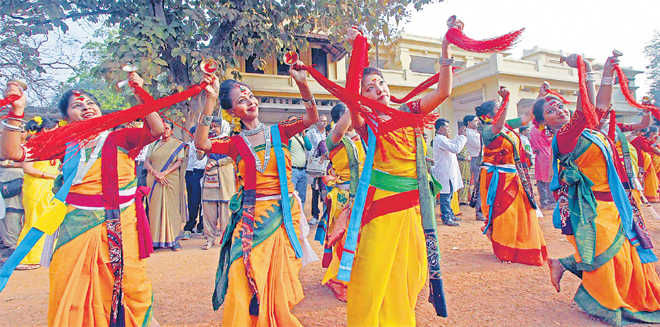Spring of our time at Santiniketan
Shubhadeep Choudhury in Santiniketan
If you were to splash the canvas of your life with the fondness of the memories cherished, you’d sure say: “I celebrate myself.” That’s been the spirit of Bolpur, about a three-hour drive from Kolkata, and over a century-and-a-half later, since it chose to imbue itself in Rabindranath Tagore’s ideals of celebrating, reinventing life. Thus, when it’s Holi in North India, it is Basanta Utsav at Sangit Bhavana, the music school attached to the Visva-Bharati University set up by Tagore at Santiniketan, near Bolpur.
This spring the students presented Tagore’s Nabin, a music-dance performance. Women, about 50 of them, stood haphazardly in front of Sangit Bhavana’s concrete dais. The sari they wore had the end of the cloth wrapped round the waist and tucked there. As the music began, the women stood in a row and danced their way on to the stage. The next 90 minutes were memorable.
The festivities started on Feb 28 evening with Basanta Bandana (hymns sung in praise of the spring season) and Boitalik (consisting of songs having no fixed rhythm pattern). The festivities concluded with the staging of Tagore’s dance-drama Chandalika (a story involving an untouchable woman, Prakriti, and Anand, the disciple of Buddha. It tells you about a larger meaning of love: liberation without ‘possession’).
Tagore did not encourage celebration of religious festivals within the institution. He introduced a system of feting the seasons. Basanta Utsav, which coincides with Holi (in Bengal, Holi is called ‘dol’), is the celebration of the spring season. Besides music and dance, it is also celebrated with a good splash of colours.
Over the years not much has changed in the nature of the cultural programme. Yet, from being a festival meant for the small Santiniketan community, it has become a huge tourist spectacle. Around two lakh people turned up for the previous edition of the Basanta Utsav. After the cultural events ended around 9.30am at the ‘ashram’ ground of the university, a massive traffic snarl built up on the three approach roads to Santiniketan. It took over five hours for the roads to clear.
This time there everyone expected a bigger crowd. Amartya Mukherjee is in-charge of the Basanta Utsav festivities. He is also the drama teacher at Visva Bharati and president of Visva Bharati Karmi Parishad. He says 1,500 policemen were posted within the university premises during the celebration. And that’s what upsets Ashram’s old-timers.
A Visva-Bharati veteran recalls how Santidev Ghosh, the Padma Bhushan recipient and legendary principal of Sangit Bhavana, thwarted a campaign by the West Bengal government to promote Santiniketan as a tourist spot. Ghosh, while returning from Kolkata, noticed a billboard put up at the Howrah station asking tourists to visit Santiniketan. Ghosh called up Jyoti Basu, the then chief minister, and requested him to have the billboard removed. Ghosh, whose musical talent was acknowledged by Tagore himself, did not want Santiniketan to become a weekend picnic spot.
“Basanta Utsav has become like a nightmare for us. We do not go out of our houses during the function”, says Mohan Singh, a veteran of the Sangit Bhavana, who is also one of the most respected figures at Visva Bharati. “Had Tagore been alive, he would have shifted Visva Bharati to some remote hill,” says Mohan Singh.
In the bygone days, Basanta Utsav was celebrated at the Gaur Prangan, a courtyard on the campus. From Gaur Prangan, the festival has been shifted to the huge ashram ground to accommodate the visitors.
And Basanta Utsav is only the second biggest festival of Santiniketan. Poush Mela, held in the winter and known for the presence of Bengal’s famous folk singers (baul), is bigger than Basanta Utsav. The mela also lasts longer.
Santiniketan receives another set of visitors. The place being close to Kankalitala, one of the Shakti Peethas, is included in their travel map by those coming to offer puja at the Kankalitala temple. These visitors stand outside when they reach Santiniketan.
“Santiniketan does not have a well-defined campus. We cannot prevent people from coming here”, says the drama teacher Amartya Mukherjee.
Unlock Exclusive Insights with The Tribune Premium
Take your experience further with Premium access.
Thought-provoking Opinions, Expert Analysis, In-depth Insights and other Member Only Benefits
Already a Member? Sign In Now










